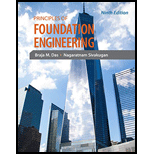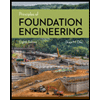
Principles of Foundation Engineering (MindTap Course List)
9th Edition
ISBN: 9781337705028
Author: Braja M. Das, Nagaratnam Sivakugan
Publisher: Cengage Learning
expand_more
expand_more
format_list_bulleted
Concept explainers
Question
Chapter 2, Problem 2.13P
(a)
To determine
Check whether the clay is normally consolidated or overconsolidated.
(b)
To determine
Find the final consolidation settlement.
Expert Solution & Answer
Trending nowThis is a popular solution!

Students have asked these similar questions
Q#3: For a normally consolidated clay layer in the field, the following values are given.
Thickness of clay layer = 2.6 m
Compression index = 0.28
Average effective pressure on clay layer 127 KN/m²
Secondary compression index = 0.02
Δσ’ = 46.5 KN/m²
Void ratio = 0.8
Time of Primary settlement = 1.5 years
What is the total consolidation of the clay layer five years after the primary consolidation settlement?
The figure below shows a 20 m thick layer of normally consolidated clay (ϒt = 18.6 kN/m3) that is one-dimensionally loaded by Δσv = 60 kPa. The clay layer is below a 5 m thick layer of granular fill (ϒt = 19.6 kN/m3), and a dense, compacted glacial till underlies the clay. The water table is located at the top of the clay layer. A 1-D consolidation test is performed on a 3.00 cm thick, doubly drained specimen from the middle of the clay layer. When the stress conditions from the field (including the Δσv = 60 kPa) are applied to this specimen, it takes 1.5 minutes for 60% average consolidation to occur.a. From the lab test data, determine cv for the soil.b. Compute pore water pressure at 20 m depth 7 years after the Δσv is applied to the clay layer.
c. Compute the average degree of consolidation 7 years after Δσv application.
The figure below shows a 24 m thick layer of normally consolidated clay (ϒt = 18.6 kN/m3) that is one-dimensionally loaded by Δσv = 100 kPa. The clay layer is below a 4 m thick layer of granular fill (ϒt = 19.6 kN/m3), and a dense, compacted glacial till underlies the clay. The water table is located at the top of the clay layer. A 1-D consolidation test is performed on a 2.50 cm thick, doubly drained specimen from the middle of the clay layer. When the stress conditions from the field (including Δσv = 100 kPa) are applied to this specimen, it takes 6 min for 90% average consolidation to occur.a. From the lab test data, determine cv for the soil.b. Compute the pore pressure at depth 22 m before and immediately after the 100 kPa stress is applied.c. At depth 22 m, compute the pore pressure 8.5 years after the 100 kPa is applied.
Chapter 2 Solutions
Principles of Foundation Engineering (MindTap Course List)
Knowledge Booster
Learn more about
Need a deep-dive on the concept behind this application? Look no further. Learn more about this topic, civil-engineering and related others by exploring similar questions and additional content below.Similar questions
- A stratified soil sample has the following profile characteristics: LAYER 1: The upper later is a 4-m thick sand layer with void ration = 0.61 and specific gravity of solids = 2.65. LAYER 2: The lower layer is a 5-m thick clay layer with void ration = 0.48 and specific gravity of solids = 2.67. If the ground water table is situated at the interface between the sand and clay layers, evaluate the effective stress (in kPa) at the bottom of the sand layer, and the effective stress at the bottom of the clay layer.arrow_forwardFor a normally consolidated soil, the following is given: Determine the following: a. The compression index, Cc. b. The void ratio corresponding to pressure of 200 kN/m2arrow_forwardDetermine the average vertical permeability in mm/s of a soil mass made up of three horizontal strata, each 1 m thick, if the coefficients of permeability are 1 × 10^–1 mm/s, 3 × 10^-1 mm/s, and 8 × 10^–2 mm/s for the three layers.arrow_forward
arrow_back_ios
arrow_forward_ios
Recommended textbooks for you
 Principles of Foundation Engineering (MindTap Cou...Civil EngineeringISBN:9781337705028Author:Braja M. Das, Nagaratnam SivakuganPublisher:Cengage Learning
Principles of Foundation Engineering (MindTap Cou...Civil EngineeringISBN:9781337705028Author:Braja M. Das, Nagaratnam SivakuganPublisher:Cengage Learning Fundamentals of Geotechnical Engineering (MindTap...Civil EngineeringISBN:9781305635180Author:Braja M. Das, Nagaratnam SivakuganPublisher:Cengage Learning
Fundamentals of Geotechnical Engineering (MindTap...Civil EngineeringISBN:9781305635180Author:Braja M. Das, Nagaratnam SivakuganPublisher:Cengage Learning Principles of Geotechnical Engineering (MindTap C...Civil EngineeringISBN:9781305970939Author:Braja M. Das, Khaled SobhanPublisher:Cengage Learning
Principles of Geotechnical Engineering (MindTap C...Civil EngineeringISBN:9781305970939Author:Braja M. Das, Khaled SobhanPublisher:Cengage Learning Principles of Foundation Engineering (MindTap Cou...Civil EngineeringISBN:9781305081550Author:Braja M. DasPublisher:Cengage Learning
Principles of Foundation Engineering (MindTap Cou...Civil EngineeringISBN:9781305081550Author:Braja M. DasPublisher:Cengage Learning

Principles of Foundation Engineering (MindTap Cou...
Civil Engineering
ISBN:9781337705028
Author:Braja M. Das, Nagaratnam Sivakugan
Publisher:Cengage Learning

Fundamentals of Geotechnical Engineering (MindTap...
Civil Engineering
ISBN:9781305635180
Author:Braja M. Das, Nagaratnam Sivakugan
Publisher:Cengage Learning

Principles of Geotechnical Engineering (MindTap C...
Civil Engineering
ISBN:9781305970939
Author:Braja M. Das, Khaled Sobhan
Publisher:Cengage Learning

Principles of Foundation Engineering (MindTap Cou...
Civil Engineering
ISBN:9781305081550
Author:Braja M. Das
Publisher:Cengage Learning